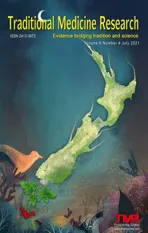Study on possible synergistic anticancer cachexia effects of the main active compounds of Radix Sophorae flavescentis
2021-07-07HongZhangLinLinChenMengYiChiXiPengSunQuanJunYangLiLiWanChengGuo
Hong Zhang,Lin-Lin Chen,Meng-Yi Chi,Xi-Peng Sun,Quan-Jun Yang,Li-Li Wan,Cheng Guo,3*
1Department of Pharmacy,Shanghai Jiao Tong University Affiliated Shanghai Sixth People’s Hospital,Shanghai 200233,China;2School of Medicine,Shanghai Jiao Tong University,Shanghai 200240,China;3School of Pharmacy,Shanghai University of Traditional Chinese Medicine,Shanghai 201203,China.
Abstract Background:Cancer cachexia is a complex disease secondary to cancer,and no specific therapy for it has been found.The Chinese herb Kushen(Radix Sophorae flavescentis)is the dried root of Sophora flavescens Aiton,which has been widely applied in treating digestive and urinary inflammatory diseases.Matrine,one of the main components of Radix Sophorae flavescentis,can alleviate cancer cachexia.Methods:Compounds from Radix Sophorae flavescentis were screened using the Traditional Chinese Medicine Systems Pharmacology Database and Analysis Platform.The targets related to cancer cachexia were queried from the Therapeutic Target Database(http://db.idrblab.net),DisGeNET database(http://www.disgenet.org),and Search Tool for Interacting Chemicals database,related literature,and constructed cancer cachexia-protein network.Cancer cachexia-protein network was merged with compound-protein networks respectively using Cytoscape software as well as network topology data and key targets counting.Pathway enrichment analysis was conducted via the Database for Functional Annotation Bioinformatics Microarray Analysis.Protein crystal structures and compound structures were queried from RCSB and PubChem databases,respectively.Molecular docking was conducted using Discovery Studio software.Results:The anticancer cachexia compounds of Radix Sophorae flavescentis were screened as oxymatrine,matrine,and kurarinol,and targets such as BIRC2,TNF and STAT3 were found.The mechanisms of oxymatrine,matrine,and kurarinol have the characteristics of synergy and complementarity.Kurarinol has a mechanism similar to that of matrine,which includes the FoxO signaling pathway,insulin resistance and mTOR signaling pathway.TNF signaling pathway is a common signaling pathway of kurarinol,oxymatrine and matrine.Adipocytokine signaling pathway is the other common pathway of kurarinol and oxymatrine except for the TNF signaling pathway.Kurarinol can be successfully docked with CYCS,GPX2,BIRC7,etc.,and kushenol C can be successfully docked with IKBKB and PIK3CD.Conclusion:Kurarinol,matrine,oxymatrine,and kushenol C may be the key compounds of Radix Sophorae flavescentis treating cancer cachexia.Additionally,TNF signaling pathway is the key pathway for the synergistic action of kurarinol,matrine and oxymatrine.
Keywords:Radix Sophorae flavescentisn,Cancer cachexia,Kurarinol,Matrine,Oxymatrine,TNF signaling pathway
Background
Cancer is one of the most serious diseases in the history of human health,for which the whole society bears a huge material and spiritual burden.In 2018,it was estimated that 18.1 million new cancer cases and 9.6 million cancer deaths occurred worldwide[1].Cancer cachexia is a complex disease secondary to cancer,which is accompanied by systemic sexual dysfunction and tissue atrophy.Cancer cachexia is characterized by systemic inflammation,negative energy and protein balance,weight loss accompanied by skeletal muscle atrophy,and fat tissue consumption[2,3].Fifty to eighty percent of cancer patients will have cachexia,and at least 20% of them will die directly from cachexia[4].Additionally,cancer cachexia will increase the length of stay and cost of patients and increase the medical burden[5].It has been generally believed that the only way to treat cachexia is to cure cancer,but even if the tumor is removed,weight loss will last for a long time,and also,several chemotherapy and targeted treatment schemes have large side effects,which will also affect the weight,physical strength,and quality of life of patients and further aggravate cachexia[6-9].Globally,there is a lack of effective solutions because of the complexity of cancer cachexia and a large number of factors related to muscle atrophy.The development of cancer cachexia treatment is an essential topic in the determination of the causes of this type of cancer.
Radix Sophorae flavescentis,well known as“Kushen”,is a kind of traditional Chinese medicine(TCM)that has a long history of medicinal use in China.It is commonly used in the clinical treatment of TCM for dysentery,eczema,and pruritus.As described inShennong’s Classic of Materia Medica(written in the Eastern Han Dynasty,25-220 C.E.),Radix Sophorae flavescentiscan remove“Zhengjia”and“Jiju”,the preliminary knowledge of malignant tumor in the theory of traditional Chinese medicine,whose clinical symptom is similar to that of cancer in the Western medicine.Chinese patent drug compound Kushen injection(China Food and Drug Administration’s approved number:Z14021230),which mainly containsRadix Sophorae flavescentisand Baituling(Rhizoma Smilacis glabrae),is a common dosage form ofRadix Sophorae flavescentisfor clinical application.Compound Kushen injection has been put into clinical application in the adjuvant treatment of the lung,breast,esophageal,gastric,colon,liver and pancreatic cancers[10-17].It is also used to relieve cancer-related pain[18].It has been found that matrine,one of the main components ofRadix Sophorae flavescentis,can alleviate cancer cachexia in vitro and in vivo experiments,and this is also related to the anti-inflammatory effect of matrine[19,20].Radix Sophorae flavescentiscan be used to treat cancer cachexia.
Network pharmacology is a new research method of pharmaceutical pharmacology,which has been widely used in the field of TCM.By prioritizing disease-related genes,network pharmacology is to predict the target and pharmacological action of TCM compounds to reveal the drug-gene-disease relationship and to screen synergistic multicompounds from the TCM formula[21].TCM is a kind of complex treatment mode of the systematic syndrome-to-syndrome treatment,with various drug compositions and syndromes.The concept of the network target is consistent with the concept of TCM[22,23].Molecular docking can be used to predict the interaction between compounds and protein targets and to screen compounds with potential interaction for proteins with known crystal structure[24].
This study aims to investigate the potential and mechanism of anticancer effects ofRadix Sophorae flavescentisby combining network pharmacology and molecular docking methods to provide a reference for further research ofRadix Sophorae flavescentis.
Materials and methods
Construction of cancer cachexia-protein network
Therapeutic Target Database (TTD)(http://db.idrblab.net) and DisGeNET(http://www.disgenet.org)database were used to query cancer cachexia-related therapeutic targets and combining with cancer cachexia pathological process-related proteins in the literature to construct a cancer cachexia-protein network.In the DisGeNET database,screening condition is as follows:gene-disease association score≥0.01 and evidence index≥1.0.In TTD,disease type should be related to a malignant tumor.By sorting out eight biological cancer cachexia-related processes,namely,E3 ubiquitin-proteasome pathway,inflammatory response,oxidative stress,protein synthesis,adenosine triphosphate synthesis, lipolysis, apoptosis,autophagy-lysosome pathway-related proteins,a primary disease-protein network was established[25-32].
Then,the STRING(http://string-db.org)database was used to query other proteins associated with the proteins in the primary disease-protein network to build a cancer cachexia-protein network[33].The cancer cachexia-protein network diagram was constructed using Cytoscape software(Version 3.2.1)[34].The degree(DE)value and the betweenness centrality(BC)value of all nodes are counted using Cytoscape software.The nodes in the network diagrams can be compounds,proteins,and biological processes.The radiation step was used to divide the area in the network diagrams.In the network diagrams,the DE value is related to the node hue;the larger the DE value,the closer the node tone to red,and the smaller the DE value,the closer the node tone to green.The size of the BC value is positively related to the size of the node.The larger the DE and BC values are,the more important the node is in the network.In the cancer cachexia-protein network,the“cachexia”node was taken as the starting point;the neighboring nodes were selected by every step of radiation.The radiation terminated when all the nodes were selected.The first radiation-related nodes belong to S1,the second to S2,and the third to S3.The cancer cachexia-protein network contains S1-S3.
Construction of the compound-protein network
Traditional Chinese Medicine Systems Pharmacology Database and Analysis Platform(TCMSP)database(http://lsp.nwu.edu.cn/tcmsp.php)was used to query the compounds contained inRadix Sophorae flavescentisand to screen the active ingredients ofRadix Sophorae flavescentismeet the drug-like restrictions(limiting conditions:compound molecular weight(MW)<500,lipid-water partition coefficient(AlogP)<5,hydrogen bond donors(Hdon)<5,the number of hydrogen bond acceptors(Hacc)<10),and then,the Search Tool for Interacting Chemicals(STITCH)database(http://stitch.embl.de)was used to query compound-related protein to establish the compound-protein networks in Cytoscape software(Version 3.2.1)[35,36].
Construction of the compound-protein-cancer cachexia network
Compound-protein networks and cancer cachexia-protein network were merged in the Cytoscape software(Version 3.2.1).The compound node was taken as the starting point,the neighboring nodes were selected by every step of radiation.The radiation terminated when the cancer cachexia node was selected.The first radiation-related nodes belong to S1,the second to S2,the third to S3,and the fourth to S4.The protein nodes belong to S1-S4 were considered as targets,and the targets with above-mean DE value and average BC value were considered as key targets.
Pathway enrichment analysis
The protein nodes before the radiation reaches the cancer cachexia node were selected in Cytoscape software(if there is S4 in the fusion network,then all the proteins in S1,S2,and S3 areas were selected).If there is no S4,then all the proteins in S1 and S2 areas were selected).The Database for Functional Annotation Bioinformatics Microarray Analysis(DAVID)(https://david.ncifcrf.gov)was used to analyze the Kyoto Encyclopedia of Genes and Genomes(KEGG)pathway enrichment of the selected proteins[37,38].Pathways with adjustedP<0.01 were obtained and analyzed,and pathway enrichment bubble plots were drawn using R software 3.3.3.
Molecular docking
RCSB Protein Data Bank database(http://www.rcsb.org)was used to query protein crystal structure, and PubChem database(https://pubchem.ncbi.nlm.nih.gov)was used to query compound structure.Molecular docking was conducted using Discovery Studio 2016 software.The compound structures were pretreated to generate ligands(hydrogenation,to add CHARMm force field),and the crystal structures of the proteins were also pretreated:the original ligand and water molecules were deleted,the protein multi conformations were removed(clean protein),the incomplete amino acid residues were supplemented,and hydrogenation was conducted.The ligands docked into the active pockets after the original ligands were removed.After docking,the root mean square deviation(RMSD)value was calculated.When RMSD≤2.0Å,it showed that the docking method and the setting of relevant parameters can reproduce the binding mode of the original ligand-receptor(RMSD value can meet the requirements by adjusting the radius of the active pocket)[39].Then,the ligands were docked to the crystal structures of the proteins,and the Lib Score value was used as the evaluation index.The Lib Score value of>100 indicates that the ligands have potential activity for the matching protein.The larger the value,the higher the docking activity of the ligands to the target.
Results
Construction of cancer cachexia-protein network
The cancer cachexia-protein primary network comprises nine nodes related to eight biological processes: E3 ubiquitin-proteasome pathway,inflammatory response,oxidative stress,protein synthesis,adenosine triphosphate synthesis,lipolysis,apoptosis,and autophagy-lysosome pathway,as shown in Figure 1(S1).As shown in Figure 1(S2),there are 68 protein nodes related to the eight biological processes.Sixty-eight proteins were queried in the protein-protein network in the STRING database,and 349 proteins were added to the network,as shown in Figure 1(S3).The whole cancer cachexia-protein network comprises 426 nodes and 2,301 edges.
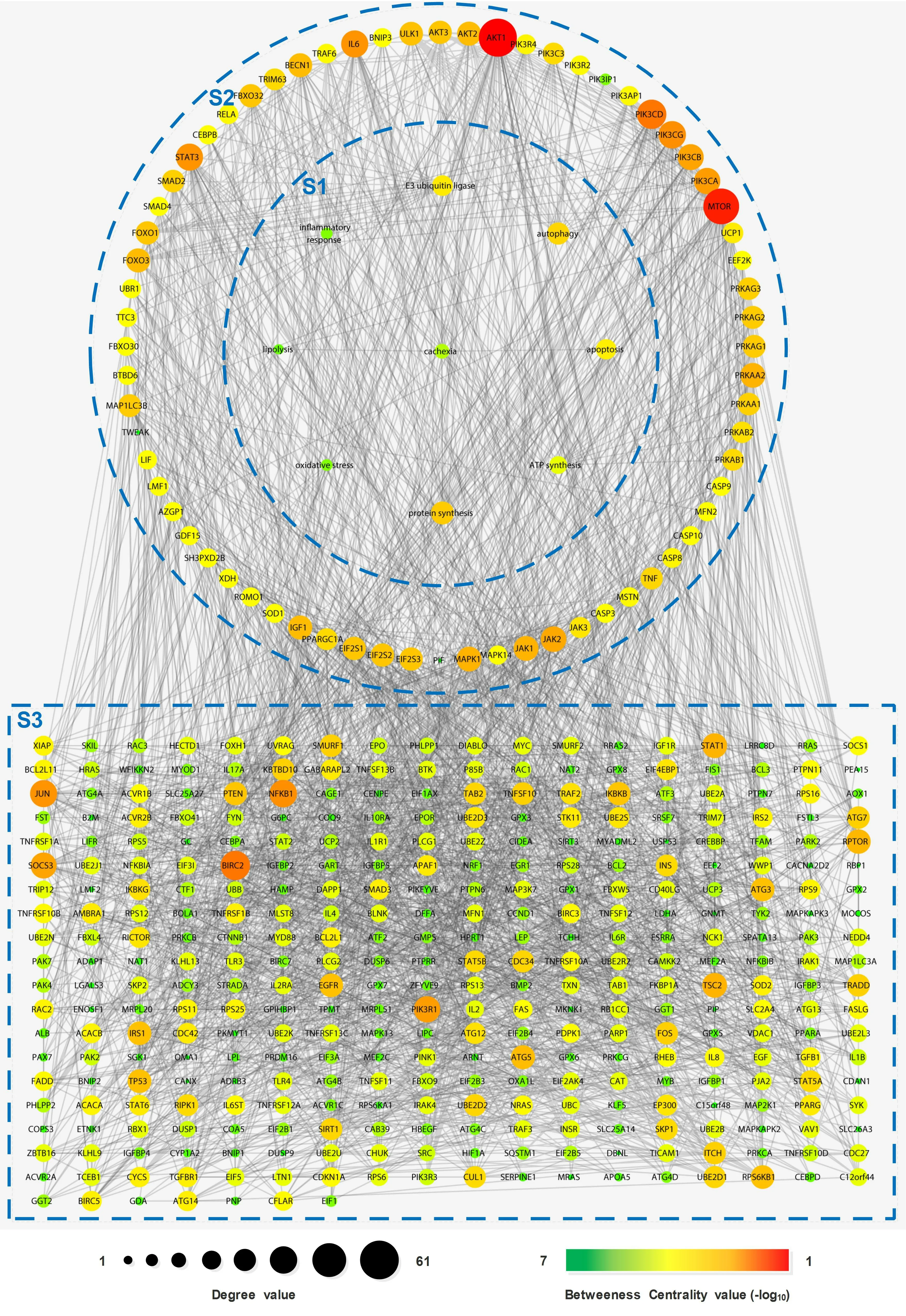
Figure 1 Cancer cachexia-protein network.The whole cancer cachexia-protein network comprises 426 nodes and 2,301 edges.In the network diagrams,the DE value is related to the node hue;the larger the DE value is,the closer the node tone to red,and the smaller the DE value is,the closer the node tone to green.The size of the BC value is positively related to the size of the node.The larger the DE and the BC values are,the more important the node is in the network.The“cachexia”node was taken as the starting point,the neighboring nodes were selected in every step of radiation.The radiation terminated when all the nodes were selected.The first radiation-related nodes belong to S1,the second to S2,and the third to S3.The cancer cachexia-protein network contains S1-S3.DE,degree;BC,betweenness centrality.
Construction of the compound-protein-cancer cachexia network
There are 63 compounds fromRadix Sophorae flavescentisthat meet the restriction conditions of drug-like properties through the query of the TCMSP database,and there are 10 compounds that can query the relationship between compounds and proteins in the STITCH database.As shown in Table 1,three compound-protein networks have successfully fused with cancer cachexia-protein network,namely,kurarinol(molecular formula:C26H32O7,MW:456.58 Da),matrine(molecular formula:C15H24N2O,MW:248.41 Da),and oxymatrine(molecular formula:C15H24N2O2,MW:264.36 Da).Supplementary Figure S1-S3,show the merged compound-protein-cancer cachexia network,respectively.
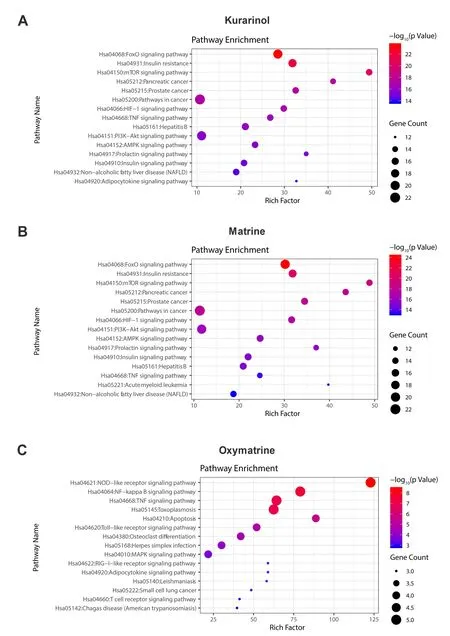
Figure 2 KEGG signaling pathway analysis bubble chart of proteins in kurarinol-protein-cancer cachexia network combined with matrine-protein-cancer cachexia network and oxymatrine-protein-cancer cachexia network.In the bubble chart,the P-value is related to the node hue;the smaller the P-value,the closer the node tone is to red.
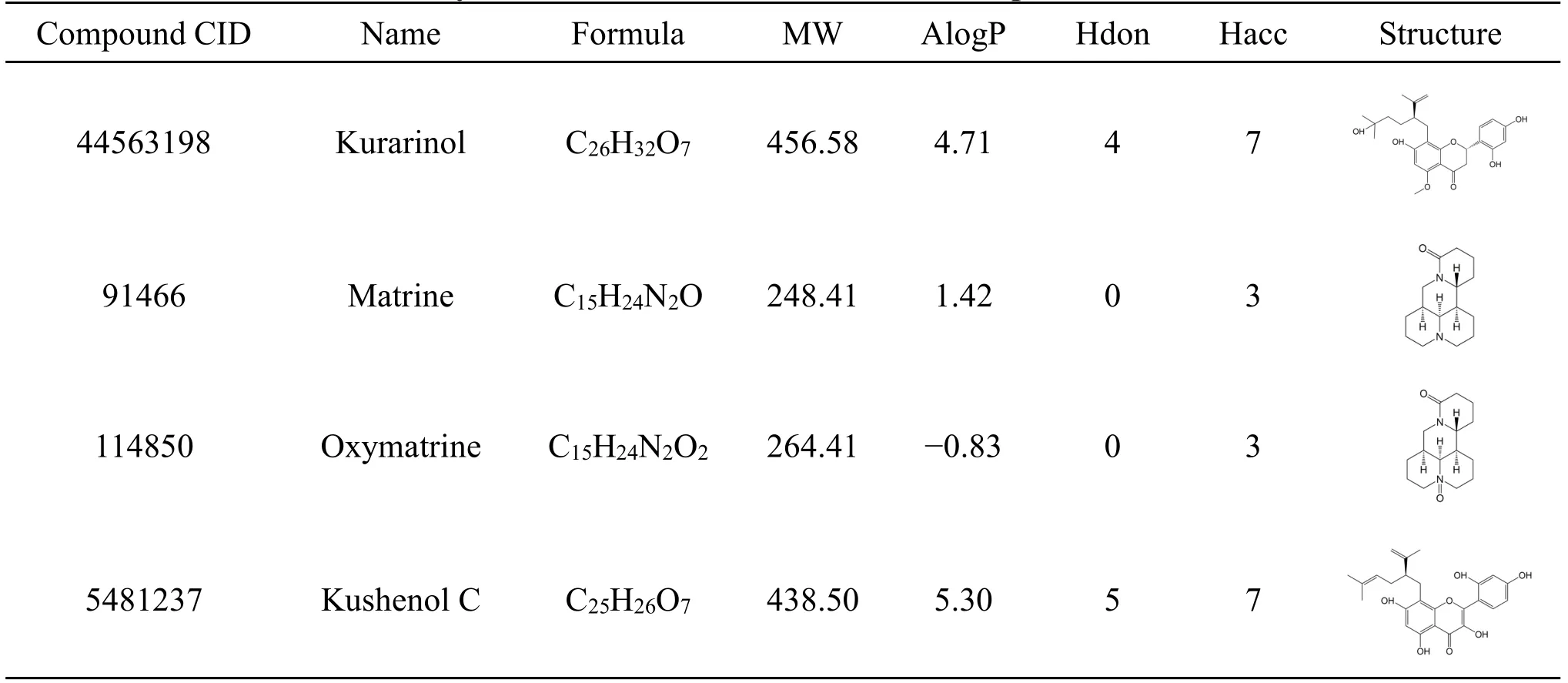
Table 1 Compounds in Radix Sophorae flavescentis successfully constructed compound-protein-cancer cachexia network or successfully docked with cancer cachexia-related protein
The gene count is positively related to the size of the node.The smaller the P-value,the larger the gene count,the more important the node is,which represents the pathway.KEGG,Kyoto Encyclopedia of Genes and Genomes.
Kurarinol-protein-cancer cachexia,matrine-protein-cancer cachexia,oxymatrine-protein-cancer cachexia network analysis,and KEGG signaling pathway enrichment analysis
The key proteins in the kurarinol-protein-cancer cachexia network include BIRC2,NFKB1,JUN,IL6,and STAT3.The protein information was extracted from the Supplementary Figure S1,and the KEGG signaling pathway enrichment was analyzed through the DAVID database.Figure 2A displays 15 pathways with the lowest P-value.The presumed signaling pathways related to kurarinol treat cancer cachexia include FoxO signaling pathway,insulin resistance,and mTOR signaling pathway.The key proteins in the matrine-protein-cancer cachexia network include AKT1,MTOR,BIRC2,PIK3CD and NFKB1.The protein information was extracted from the Supplementary Figure S2.Figure 2B presents 15 pathways from KEGG with the lowest P-value.The presumed signaling pathways related to matrine treat cancer cachexia include FoxO signaling pathway,insulin resistance,and mTOR signaling pathway.The key proteins in the oxymatrine-protein-cancer cachexia network include BIRC2,NFKB1,IKBKB,TAB2,and TNF.The protein information was extracted from Supplementary Figure S3,and Figure 2C displays 15 pathways from KEGG with the lowest P-value.The presumed signaling pathways related to matrine treat cancer cachexia include NOD-like receptor signaling pathway,NF-kappa-B signaling pathway,and TNF signaling pathway.Table 2 shows the DE and BC values of the key protein nodes in the three networks.
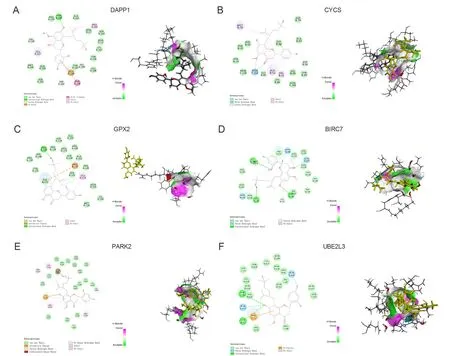
Figure 3 Diagrams of kurarinol docked with cancer cachexia-related protein crystals.Different colors of amino acids and chemical structure connecting lines represent different interactions as shown.The color of the action surface shows the hydrogen bond properties of the donor and the receptor.DAPP1,dual adaptor of phosphotyrosine and 3-phosphoinositides;CYCS,cytochrome C;GPX2,glutathione peroxidase 2;BIRC2,baculoviral IAP repeat-containing protein 2;PARK2,Parkinson disease protein 2;UBE2L3,ubiquitin-conjugating enzyme E2 L3.
By merging the protein information in the compound-protein-cancer cachexia networks of kurarinol,matrine,and oxymatrine,the targets ofRadix Sophorae flavescentistreating cancer cachexia were collected by the network pharmacology method.Based on signaling pathways enrichment analysis of compound-protein-cancer cachexia networks of kurarinol,matrine,and oxymatrine showed in Figure 2,kurarinol has a mechanism similar to that of matrine and can act on multiple common signal pathways,such as FoxO signaling pathway,insulin resistance,mTOR signaling pathway,pancreatic cancer,prostate cancer,and HIF-1 signaling pathway.TNF signaling pathway is a common signaling pathway of kurarinol,oxymatrine,and matrine.Adipocytokine signaling pathway is the other common pathway of kurarinol and oxymatrine except for the TNF signaling pathway.
Analysis of screening results of anticancer cachexia compounds related to Radix Sophorae flavescentis based on molecular docking
In the cancer cachexia-protein network,417 proteins were queried in the RCSB database,312 protein crystal structures were examined,and a total of eight proteins could be docked successfully with Lib Score>100.As shown in Figure 3,kurarinol has docked with DAPP1,CYCS,GPX2,BIRC7,PARK2,and UBE2L3.Kushenol C(molecular formula:C25H26O7,MW:438.5 Da)docked with IKBKB and PIK3CD,as shown in Figure 4,and compound information,as shown in Table 1.
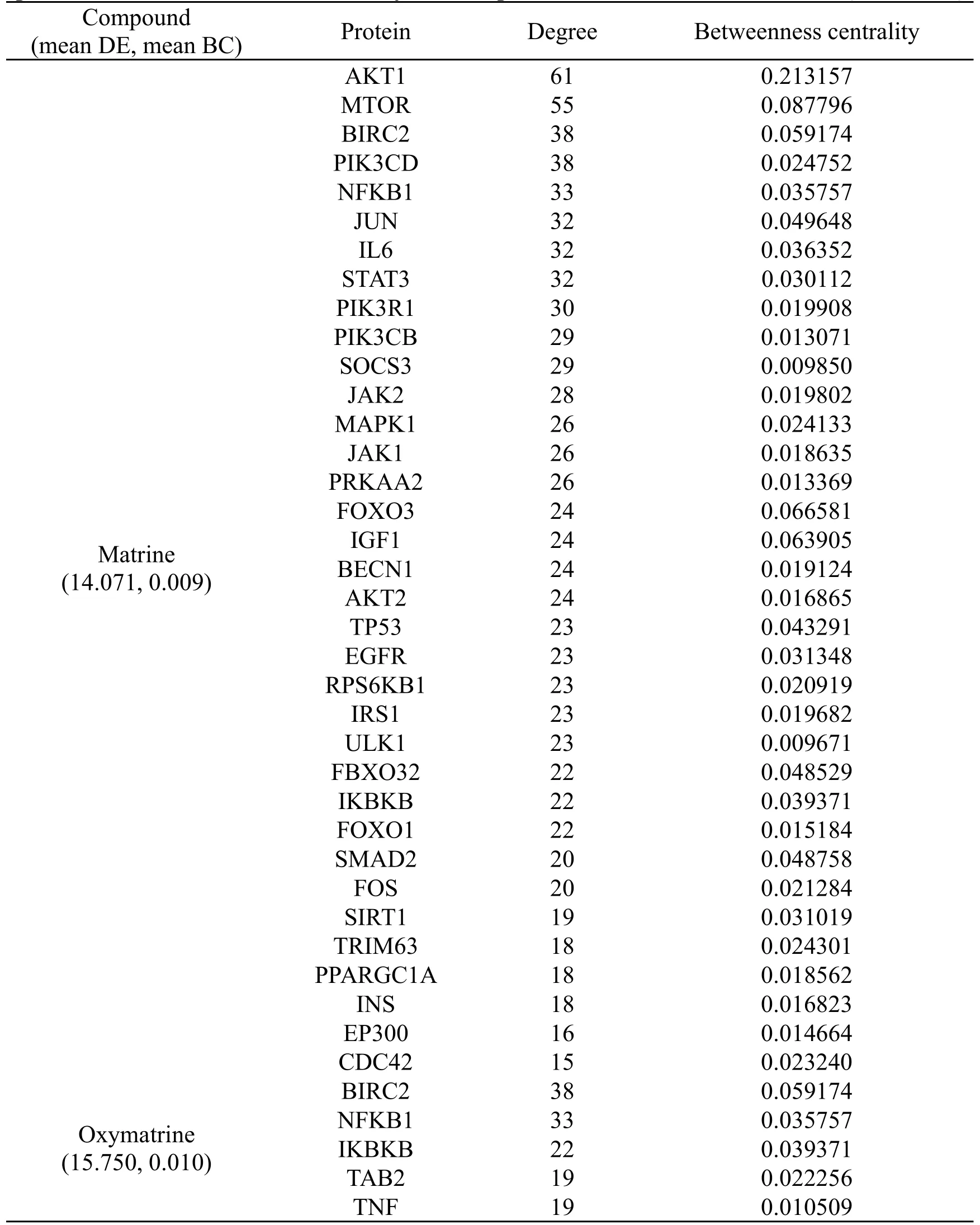
Table 2 Topological properties of the key nodes in kurarinol-protein-cancer cachexia network,matrine-protein-cancer cachexia network,oxymatrine-protein-cancer cachexia network(Continued)
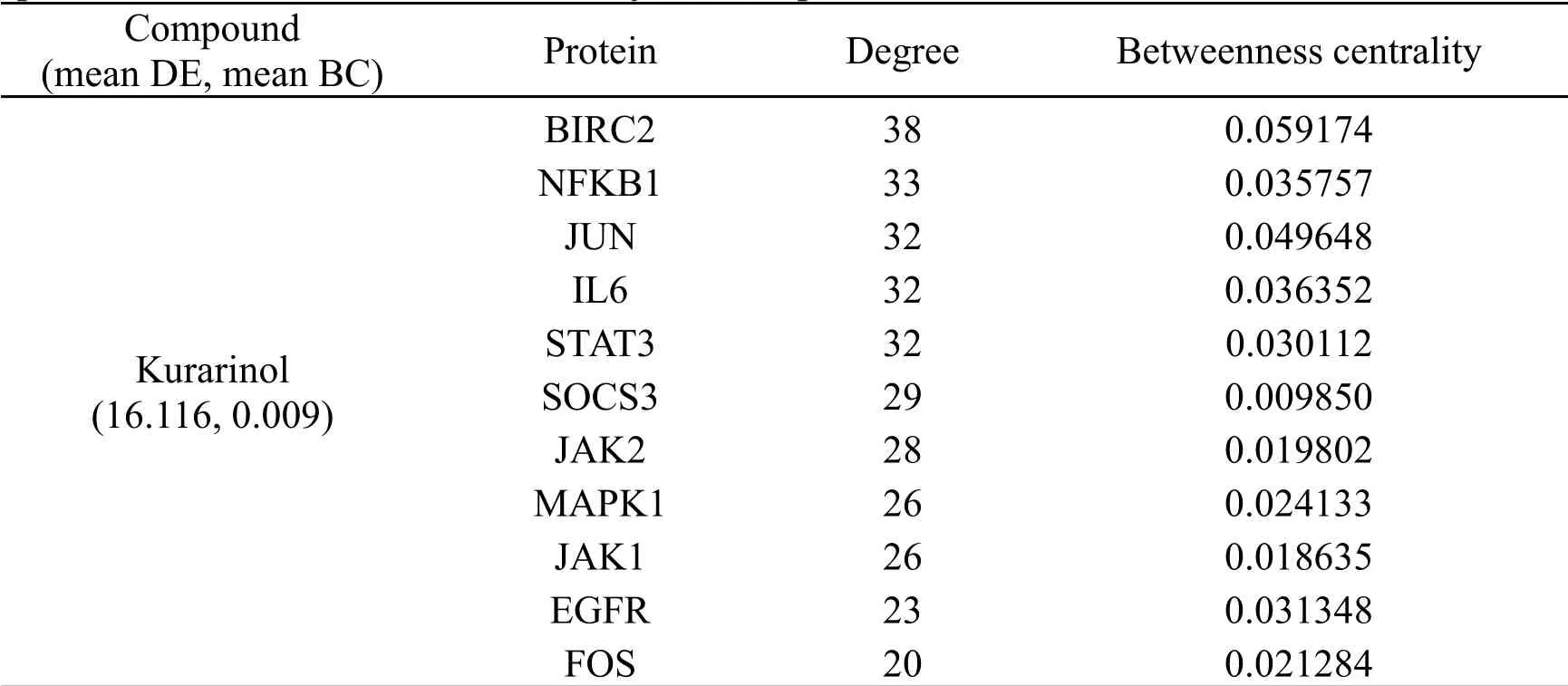
Table 2 Topological properties of the key nodes in kurarinol-protein-cancer cachexia network,matrine-protein-cancer cachexia network,oxymatrine-protein-cancer cachexia network
Kurarinol forms a strong hydrogen bond with TAPP160 of DAPP1,a weak hydrogen bond with VAL158,HIS189,TRP185,a π-alkylated connection with LEU157,an alkylated connection with Pro162,and a π-anionic connection with GLU168.It has van der Waals(vdWs)interactions with 12 amino acid sites.Kurarinol has π-alkylated linkages with ALA52 and VAL51 of CYCS,forms alkylated linkages with MET78 and ALA52,forms weak hydrogen bond linkages with GLY85 and ASP50,and has vdWs interactions with 11 amino acid sites.Kurarinol forms a strong hydrogen bond with PRO130 of GPX2,π-alkylation and alkylation connection with LEU133,and has vdWs interactions with 15 amino acid sites.Kurarinol forms strong hydrogen bonds with GLN132,GLY130,LYS146 of BIRC7,weak hydrogen bonds,and π-alkylation with LEU131 and has vdWs interactions with 12 amino acid sites.Kurarinol forms a weak hydrogen bond with GLY336 in PARK2,π-alkylation with PRO335 and PRO333,alkylation with LEU331 and ARG275,and vdWs interactions with 17 amino acid sites.Kurarinol forms a strong hydrogen bond with ASN94 and LEU73 of UBE2L3,forms a π-cation link with ARG72,and forms a vdWs interaction with 15 amino acid sites.
Kushenol C forms π-alkylated linkages with ILE165 and VAL29 of IKBKB;forms alkylated linkages with ALA42,LEU21,and TYR98;also forms π-anionic linkages with ASP103;and has vdWs interaction with 13 amino acid sites.Kushenol C and LYS708 of PIK3CD produce electrostatic attraction.Kushenol C forms strong hydrogen bonding with MET752,THR750,and ASN836 and forms a π-alkylation connection with MET752,PRO758,and ILE777 and alkylation with VAL827,VAL828,ILE910,and MET900.Additionally,kushenol C forms π-π conjugate and π-Σ connection with TRP760 and has vdWs interactions with 13 amino acid sites.As shown in Supplementary Figure S4,pathway enrichment analysis displayed that the anticancer cachexia mechanism ofRadix Sophorae flavescentisdetected by molecular docking is related to pathways as small cell lung cancer,apoptosis,B cell receptor signaling pathway,etc.
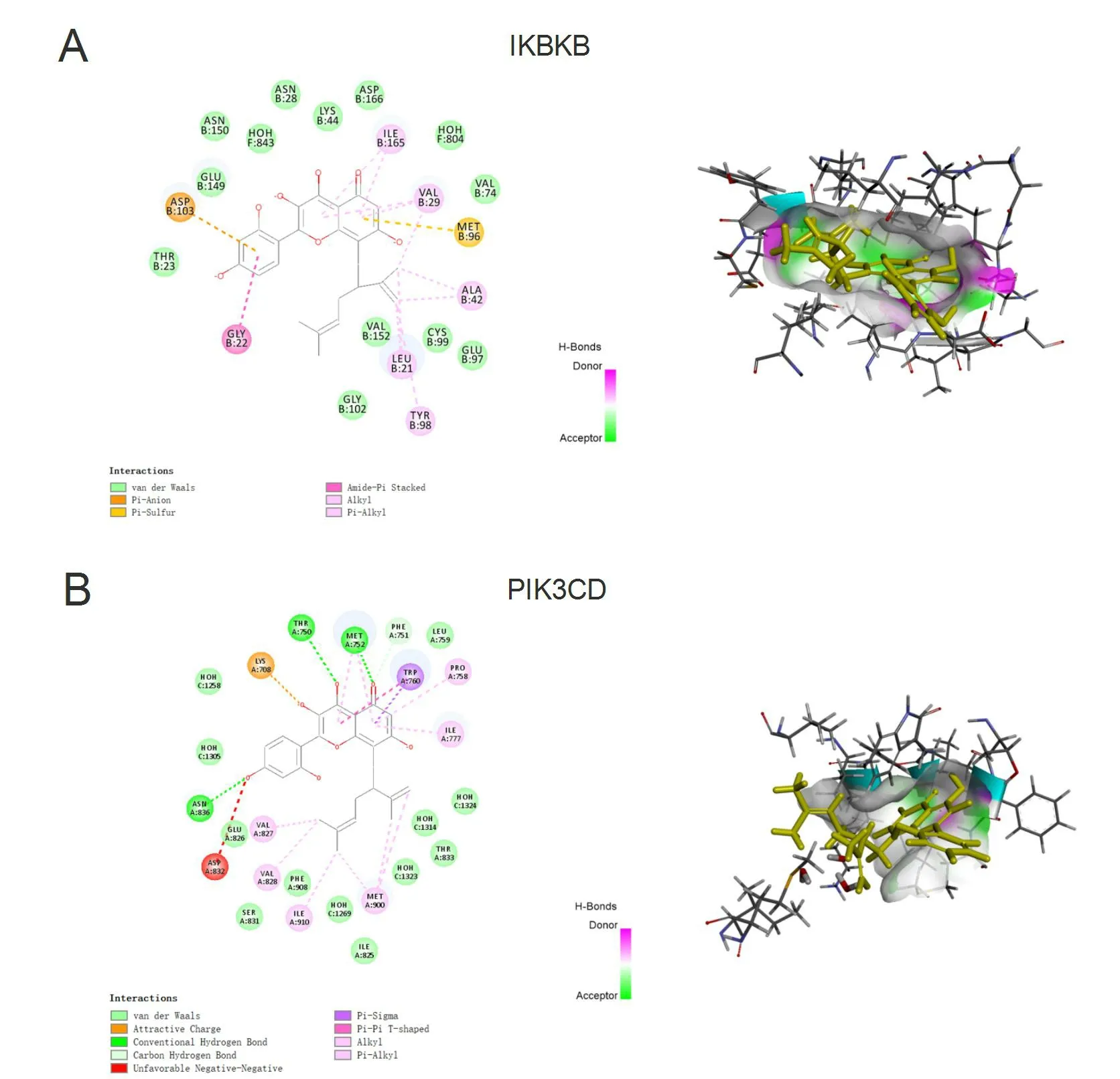
Figure 4 Diagrams of kushenol C docked with cancer cachexia-related protein crystals.Different colors of amino acids and chemical structure connecting lines represent different interactions as shown.The color of the action surface shows the hydrogen bond properties of the donor and the receptor.IKBKB,inhibitor of nuclear factor kappa-B kinase subunit beta;PIK3CD,phosphatidylinositol 4,5-bisphosphate 3-kinase catalytic subunit delta isoform.
Discussion
Cancer cachexia is a complex disease with systemic progressive dysfunction and tissue atrophy secondary to cancer,which is related to the E3 ubiquitin-proteasome pathway,inflammatory response protein synthesis,and other biological processes[25-32].At the same time,traditional chemotherapy drugs will further promote part of the pathological process.Cancer cachexia by single-target drugs is very difficult to improve.In this study,representative proteins were selected from cancer cachexia-related eight biological processes as presented above to form a cancer cachexia-protein network.In the process of building a compound-protein network with the compounds contained inRadix Sophorae flavescentisand merging with the cancer cachexia-protein network,the compound-protein networks of the three compounds were successfully merged,namely,kurarinol,matrine and oxymatrine.
Kurarinol has strong tyrosinase inhibitory activity,can inhibit cell proliferation,and has the potential to be developed into anticancer drugs[40].Kurarinol can induce apoptosis of hepatocellular carcinoma cells by inhibiting STAT3[41].Kurarinol’s regulatory effect on STAT3 may be beneficial to the alleviation of cancer cachexia.CYCS exists in the results of network pharmacology and molecular docking.CYCS is closely related to endogenous apoptosis.In the experimental model of cachexia in vitro and in vivo,CYCS can be observed as an essential target.It was observed that the expression of CYCS(encoded byCYCSgene)and CYCS oxidase complex decreased in skeletal muscle of mice with severe cachexia,which reflected that the oxidative capacity and mitochondrial dynamics of oxidative muscle and glycolytic muscle were degraded,whereas improving the oxidative capacity of skeletal muscle and normalizing energy metabolism was beneficial to the improvement of cachexia[42,43].Matrine can inhibit the proliferation of various tumor cells and induce apoptosis[44-49].Reportedly,matrine induced autophagy in SMMC7721 cells by inhibiting mammalian rapamycin target protein(mTOR).In HepG2 cells,it inhibited p53 and inhibited p53 activation.After autophagy,after AMPK is inhibited,autophagy is converted to apoptosis[50].Matrine can regulate the AMPK signaling pathway may have an impact on the progression of cancer cachexia.Another research showed that matrine can increase muscle fiber size and muscle mass in vivo in a CT26 colon cancer cachexia mouse model and can,at the same time,alleviate cachexia symptoms such as body and organ weight loss.Matrine also reduced C2C12 myotube atrophy and apoptosis induced by dexamethasone,TNF-α,and conditioned medium in vitro.This process is related to activating the AKT/mTOR/FoxO3α signaling pathway and downregulating the expression of E3 ubiquitin ligase MuRF and MAFbx,which conformed with the results of the network pharmacology analysis of matrine[19].The antioxidant and anti-inflammatory effects of matrine are beneficial for the treatment of cancer cachexia.In other studies,matrine can reduce cerebral ischemic damage in mice,reduce malondialdehyde levels,upregulate superoxide dismutase,glutathione peroxidase,and catalase expression,inhibit ischemic nerve cell apoptosis[51].Excessive reactive oxygen species production in diabetic cardiomyopathy activates TLR4/MyD88 signaling,leading to cardiomyocyte apoptosis,and matrine pretreatment improves cardiac function by inhibiting reactive oxygen species/TLR4 signaling pathways[52].Matrine can alleviate the damage of aortic endothelial cells by advanced glycation end products by inhibiting active oxygen-mediated activation of NLRP3 inflammasomes[53].Several studies have proved that oxymatrine has antitumor effects[54-58].Clinical studies have shown that oxymatrine also has a certain therapeutic effect on hepatitis B,but it is not clear whether the therapeutic effect of oxymatrine is to directly inhibit the virus or to protect liver cells after viral infection[59].Oxymatrine can alleviate inflammation and ischemic tissue damage in the stress environment of the brain,heart,kidney,and intestinal tract.This effect is mainly related to the inhibition of oxidative stress and apoptosis[60-63].Oxymatrine can also alleviate the myocardial damage of doxorubicin in rats,which is related to the inhibition of oxidative stress and apoptosis[64].This effect is of great significance for the treatment of cancer.Oxymatrine may relieve cancer cachexia caused by chemotherapy.Matrine and oxymatrine have an inhibitory effect on tumor cells and have a protective effect on normal cells in the body under stress,which is of great benefit for the treatment of cancer cachexia.In cancer patients with cachexia,the expression of inflammatory factors in tumors and serum is increased.The inflammatory environment can promote oxidative stress and fibrotic changes in tumor tissues,thereby affecting tumor progression[65,66].Antioxidant therapy can benefit patients with cachexia,but multi-target combination therapy is the best way to treat cachexia[67].
In this study,we found that TNF signaling pathway is the common signaling pathway of matrine,kurarinol,and oxymatrine.The TNF receptor superfamily has used to be a research hotspot for activating tumor cell apoptosis,and the survival pathways regulated by key factors such as NF-κB,JNK,p38,ERK,and PI3K are involved in the regulation of the TNF signaling pathway,which also appeared in the regulation network ofRadix Sophorae flavescentis[68].Activated TNF is assembled to a homotrimer and binds to its receptors;TNF-ɑbinds with TNF receptor 1 and TNF-β binds with TNF receptor 2.TNF receptor 1 signaling induces the activation of many genes,primarily controlled by two distinct pathways,the NF-κB pathway and the MAPK cascade,or apoptosis and necroptosis.TNF receptor 2 signaling activates the NF-κB pathway including the PI3K-dependent NF-κB pathway and JNK pathway leading to survival[69,70].TNF-ɑcan increase gluconeogenesis,loss of adipose tissue,and protein breakdown and,at the same time,lead to decreased synthesis of protein,lipid,and glycogen.TNF-ɑhas a direct catabolism effect on skeletal muscle,which induces muscle wasting through the induction of the ubiquitin-proteasome system[71].But only blocking TNF-ɑsignaling is ineffective for the treatment of cancer cachexia[72].Additionally,several signaling pathways are shared by matrine and kurarinol,such as the FoxO signaling pathway,insulin resistance,mTOR signaling pathway,pancreatic cancer,prostate cancer,and HIF-1 signaling pathway.Oxymatrine,matrine,and kurarinol may work together on BIRC2,which is a member of the apoptosis inhibitor protein family and can regulate apoptosis[73].Oxymatrine and kushenol C may jointly regulate IKBKB.At the same time,both matrine and kurarinol may regulate NFKB1,which shows that the four compounds have the potential to regulate the NF-κB signaling pathway.And the NF-κB signaling pathway plays an essential role in the initiation of apoptosis and several cancer signaling pathways[74].PI3KCD is involved in the immune response and is closely related to inflammation.Matrine and kushenol C may jointly regulate PIK3CD and participate in the regulation of inflammation[75].Matrine and kurarinol may also act on IL6 and STAT3 to participate in the regulation of apoptosis and inflammation,which is of great significance for the treatment of cancer cachexia[76,77].This fully reflects the characteristics of synergistic and complementary action of various components in TCM herbs,let alone the more commonly used TCM formula prescriptions containing multiple TCM herbs in clinical practice.Under cancer cachexia,carbohydrate,protein,and fat metabolism changes.Regulating cell survival and systemic inflammatory network may be the right choice to treat cancer cachexia,which shows the advantages of the TCM with a multi-component synergistic effect in the treatment of complex diseases.
In the molecular docking part,two compounds contained inRadix Sophorae flavescentiswere successfully docked with cancer cachexia-related protein targets,kurarinol,and kushenol C,respectively.Kurarinol has an affinity with DAPP1,CYCS,BIRC7,GPX2,UBE2L3 and PARK2.DAPP1 is related to inflammation and can integrate PI3K and Src kinase signals to promote Rac-dependent B cell adhesion,which promotes antigen recognition[78].The affinity of kurarinol and DAPP1 may suppress the immune response and reduce inflammation.CYCS is related to endogenous apoptosis.After the release of CYCS from mitochondria,CASP9 is activated,which then triggers endogenous apoptosis.The occurrence of apoptosis can inhibit the differentiation of myoblasts,and skeletal muscle differentiation is blocked during the development of cancer cachexia[79].BIRC7 is a member of the apoptosis-inhibiting protein family and has the potential as a molecular marker of malignant tumors[80,81].The affinity of kurarinol and BIRC7 may be related to the antitumor effect of kurarinol.GPX2 is also a negative apoptosis-associated protein,and high expression is associated with poor prognosis of tumors[82,83].The inhibition of GPX2 on apoptosis is related to its effect on inhibiting oxidative stress[84].If kurarinol inhibits GPX2,it may be beneficial for antitumor effects.The opposite is to protect cells under oxidative stress.For example,chemotherapy can cause skeletal muscle cells to undergo oxidative stress and cause skeletal muscle atrophy[85].Kurarinol promotes GPX2 to inhibit oxidative stress and protect cells from muscle atrophy.Ubiquitin ligase UBE2L3 can promote TNF-α induced ubiquitination and protein degradation and can also activate NF-κB to mediate inflammatory response[86].PARK2 is also a ubiquitin ligase,which has a mutual promotion effect with UBE2L3[87].Kurarinol may inhibit the activation of these two proteins,inhibit the ubiquitin-proteasome pathway, inhibit protein breakdown,and reduce skeletal muscle atrophy.Kushenol C is successfully docked with IKBKB and PIK3CD.IKBKB is closely related to protein synthesis,inflammation,and oxidative stress[88].Kushenol C may inhibit NF-κB mediated biological processes that promote the development of cancer cachexia by inhibiting IKBKB.The PI3K signaling pathway can mediate inflammatory responses[89].The possible inhibition of PIK3CD by kushenol C may inhibit inflammation and reduce cachexia.
Figure 5 summarizes the process and results.The application of network pharmacology in the pharmacological research of TCM can well reflect the characteristics of multi-component and multi-target of TCM.Molecular docking can effectively screen TCM-related compounds with potency.The combination of network pharmacology and molecular docking can be used to explain the pharmacodynamic basis of TCM and screen out compounds with potential for drug transformation from a large number of related compounds of TCM.It provides a feasible research method for the complex research of TCM.However,both network pharmacology and molecular docking depend on the information database of protein-protein interaction and compound-protein interaction.The accuracy of database data directly affects the results.The corresponding research results may be difficult to repeat when the database is updated.Thus,this research method has a strong timeliness character.To ensure the accuracy,the research results should be regularly updated.Additionally,the strong affinity between the compound and the protein in molecular docking only indicates the potential of interaction between the compound and the protein,which does not directly indicate that the function of the compound to the protein has changed.Therefore,network pharmacology and molecular docking are not yet ready to fully explain the interaction of compounds and proteins,only to predict the possible roles and mechanisms.
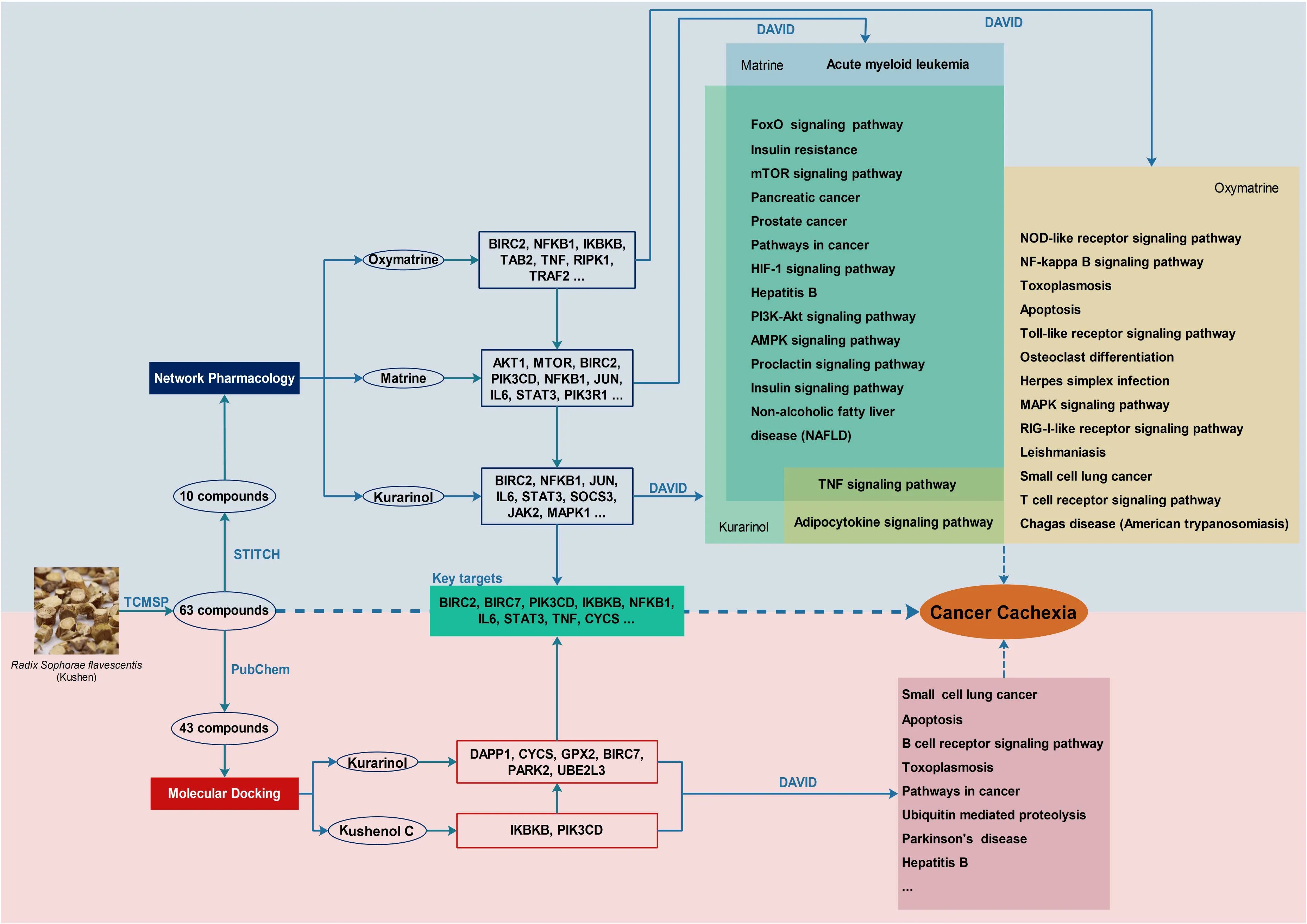
Figure 5 Summary diagram of study process and results.The anticancer cachexia compounds of Radix Sophorae flavescentis were screened through network pharmacology methods as oxymatrine,matrine,and kurarinol.Targets such as BIRC2,TNF,and STAT3 were found.The mechanisms of oxymatrine,matrine,and kurarinol have the characteristics of synergy and complementarity.Kurarinol has a similar mechanism with matrine,including FoxO signaling pathway,insulin resistance,mTOR signaling pathway.TNF signaling pathway is a common signaling pathway of kurarinol,oxymatrine,and matrine.Adipocytokine signaling pathway is the other common pathway of kurarinol and oxymatrine except for the TNF signaling pathway.Additionally,the anticancer cachexia compounds of Radix Sophorae flavescentis were screened by molecular docking methods as kurarinol,Kushenol C.BIRC7,IKBKB,PIK3CD,and other targets were found.Pathway enrichment analysis showed that the anticancer cachexia mechanism of Radix Sophorae flavescentis is related to pathways as small cell lung cancer,apoptosis,B cell receptor signaling pathway,etc.TCMSP,the Chinese Medicine System Pharmacological Analysis Platform;STITCH,Search Tool for Interacting Chemicals;DAVID,Database for Functional Annotation Bioinformatics Microarray Analysis;BIRC2,baculoviral IAP repeat-containing protein 2;TNF,tumor necrosis factor;IKBKB,inhibitor of nuclear factor kappa-B kinase subunit beta;PIK3CD,phosphatidylinositol 4,5-bisphosphate 3-kinase catalytic subunit delta isoform;STAT3,signal transducer and activator of transcription 3;FoxO,forkhead box protein O;mTOR,mammalian target of rapamycin;BIRC7,baculoviral IAP repeat-containing protein 7.
Conclusion
Kurarinol,matrine,oxymatrine,and kushenol C are the key compounds ofRadix Sophorae flavescentisin treating cancer cachexia screened by network pharmacology and molecular docking,and BIRC2,BIRC7,PI3KCD,IKBKB,NFKB1,and other proteins may be related to the anticancer cachexia molecular mechanism ofRadix Sophorae flavescentis.The mechanisms of the key compounds have the characteristics of synergy and complementarity.Kurarinol has a similar mechanism with matrine,including FoxO signaling pathway,insulin resistance,and mTOR signaling pathway.TNF signaling pathway is a common signaling pathway of kurarinol,oxymatrine,and matrine.Adipocytokine signaling pathway is the other common pathway of kurarinol and oxymatrine except for the TNF signaling pathway.
杂志排行
Traditional Medicine Research的其它文章
- Phytochemical composition,therapeutical and pharmacological potential of Nigella sativa:a review
- Network analysis and molecular docking of the mechanism of Shengmai decoction in treating patients with severe novel coronavirus pneumonia
- Traditional Chinese medicine of Salvia miltiorrhiza Bunge:a review of phytochemistry,pharmacology and pharmacokinetics
- Network pharmacology-based approach to investigate the mechanism of Huang-Lian-Jie-Du-Decoction for treatment of type 2 diabetes mellitus
- System pharmacology-based dissection of the potential effective material basis and mechanism of Xiaoxianxiong decoction for type 2 diabetes mellitus
- Pharmacological research progress of ursolic acid for the treatment of liver diseases
